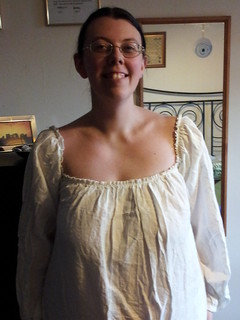That was the sound of July, August, and most of September whizzing past me. Sorry about that. Things have been pretty hectic in Fiendishland. Raglan happened at the beginning of August. It was fabulous and stressful - fabulous for seeing people and doing things, stressful because I was helping to run it and we had a food co-op this year. Anyway.
New Frock 1.0 was successfully finished, and I am rather happy with it.
There is a fair amount of tweaking and adjusting that needs to happen for New Frock 2.0, but this is a functional garment that is comfortable. Also visible here is the velvet sash I made to go with it. Could probably have done with a longer one, but I might have gone mad if I'd had to sew it for a moment longer.
For bonus points, the lacing rings as I was attaching them:
I also made an overdress to go with both this version and the silk one, once it's done. The overdress is reproduction 16th-century fabric, so a little later than the style of the dress, but I love it utterly.
The pattern on the fabric was perfectly centred, so I was able to use it as a cutting guideline. Consequently, it lines up really well.
Here's a picture of the combo, taken at Raglan by my friend Ian Walden. (Photo used with permission.) I still need sleeves, a partlet, and a proper cap, but I'm pretty happy with how it came out!
A spot where I can record all the obsessive details of my needlework, as precisely as I want.
Saturday, 19 September 2015
Monday, 22 June 2015
Suddenly, a necklace!
I went up to the sewing and bead shop this morning to buy supplies. Found black cord that will do nicely for lacing at 35p a metre, which was excellent. I also got the supplies to turn my brooch into a Florentine-style necklace.

I have no experience with making jewelry, nor do I have any intention of taking it up. This piece is intended to do until such time as I have the money to buy the real thing; consequently, I've done very little research into how to assemble it. It just needs to look right.
So. I inserted head pins through the pearl drops. (Plastic pearls, because the shop doesn't sell real pearls that were big enough.)
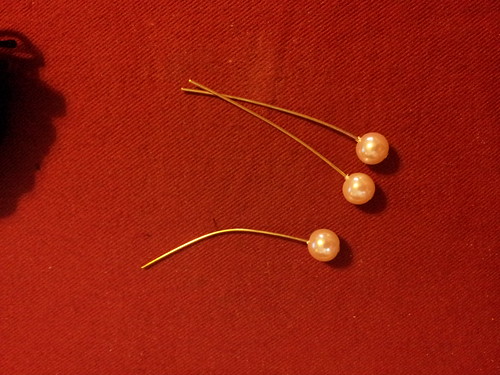
Then I started wrapping the head pin through the curlies of the brooch. I'd intended to use jump rings, but the ones I got were too small to fit around the bits of the brooch. This would have been easier if I could remember what I did with my needle-nose pliers, but hey, it worked.
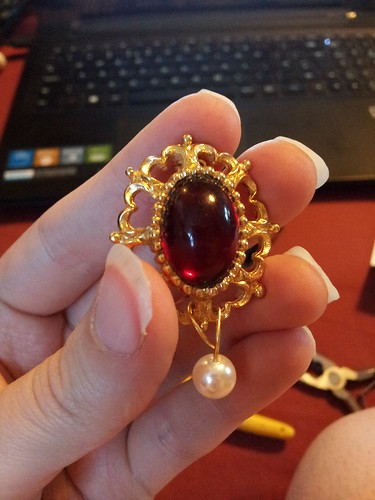
The first one was a bugger to get into place because I left the pin on the back of the brooch. The other two were not nearly so fiddly. I used my trusty Warhammer clippers to trim the head pins off after they'd been attached.
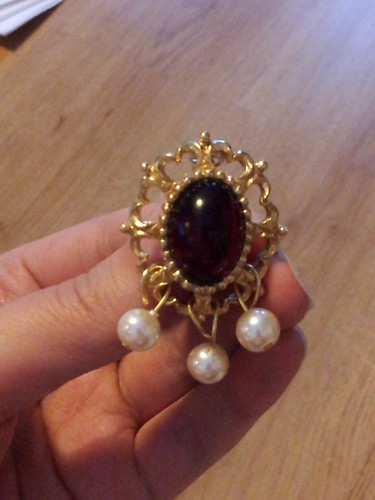
I got enough of the cord to use for the necklace too, and I think it looks rather well!


I have no experience with making jewelry, nor do I have any intention of taking it up. This piece is intended to do until such time as I have the money to buy the real thing; consequently, I've done very little research into how to assemble it. It just needs to look right.
So. I inserted head pins through the pearl drops. (Plastic pearls, because the shop doesn't sell real pearls that were big enough.)

Then I started wrapping the head pin through the curlies of the brooch. I'd intended to use jump rings, but the ones I got were too small to fit around the bits of the brooch. This would have been easier if I could remember what I did with my needle-nose pliers, but hey, it worked.

The first one was a bugger to get into place because I left the pin on the back of the brooch. The other two were not nearly so fiddly. I used my trusty Warhammer clippers to trim the head pins off after they'd been attached.

I got enough of the cord to use for the necklace too, and I think it looks rather well!

Sunday, 21 June 2015
In honour of a wee small
We spent this weekend visiting Lord and Lady Coventry, two members of our SCA household. The main purpose of the visit was to meet their recently-born sprog, Nemo[1]. He is utterly adorable despite having thrown up on me twice.
I'd made him a hat before he hatched, but I had a partially-worked piece of embroidery I designed back in March when Terry Pratchett passed away. As Nemo's parents are huge Pratchett fans, and as the quotation in question seemed remarkably apt for the start of a new life, I decided to add the relevant details and call it a birth sampler. I think it came out rather well, personally.
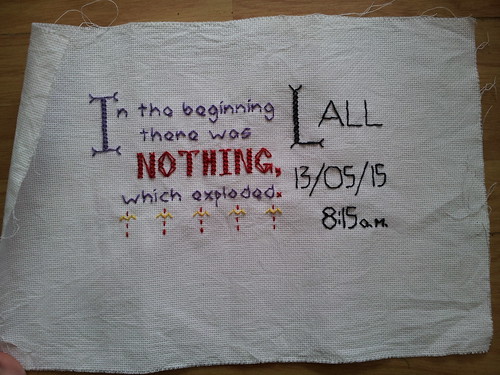
Worked over two on 14-ct Aida cloth in some mysterious hemp embroidery floss. I ended up using it as it came from the hank rather than splitting it into strands. It seemed in keeping with the heavy fabric and juvenile style. Anyway, the parents seem to like it. At least, they bought a frame for it within an hour of me presenting them with it...
[1]Not his actual name.
I'd made him a hat before he hatched, but I had a partially-worked piece of embroidery I designed back in March when Terry Pratchett passed away. As Nemo's parents are huge Pratchett fans, and as the quotation in question seemed remarkably apt for the start of a new life, I decided to add the relevant details and call it a birth sampler. I think it came out rather well, personally.

Worked over two on 14-ct Aida cloth in some mysterious hemp embroidery floss. I ended up using it as it came from the hank rather than splitting it into strands. It seemed in keeping with the heavy fabric and juvenile style. Anyway, the parents seem to like it. At least, they bought a frame for it within an hour of me presenting them with it...
[1]Not his actual name.
Saturday, 20 June 2015
Next steps
V. 1 of the dress isn't finished yet, but a lot more goes into the outfit than just the dress. Apart from figuring out how to style my hair I have a whole range of accessories I also need to make.

Sleeves
The biggest thing I still need to make is a pair of sleeves. The fabric looks like velvet to me so I've acquired a couple of yards of silk/rayon velvet. While the upper sleeve is clearly a solid tube (you can see the inside of one arm and the outside of the other), the lower sleeve is open like a gauntlet. This is rather convenient, since it appears to be in the same proportion on the model's arm as my archery bracer.
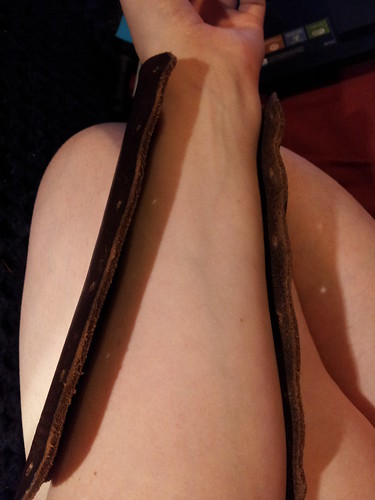
The tube of the upper sleeve appears to have a slight, angled sleeve cap rather than the rounded shape that would let it rest flush against the torso, and the bottom edge appears likewise angled (albeit more sharply). The angles could be an illusion caused by the puff of camicia protruding from underneath, but certainly at the bottom edge the camicia is clearly draping down and away from the upper sleeve.
What I am particularly uncertain of is whether I ought to line the sleeves. I'm inclined to think yes, simply to protect the edges of the velvet.
Sash
The narrow sash appears to be made of the same fabric as the sleeves. I'll cut the velvet the full length of the piece, which is 2m plus about 6 inches. (The seller cut it very generously!)
Partlet
Our subject is wearing a sheer partlet that somehow fastens under the arms and miraculously stays put over the bosom. Tyger Friend theorizes that part of the weird stuff going on with the lacing is actually a brooch that holds the partlet in place. No idea how it fastens under the arms, nor what the shape of the back is. I have half a yard of gorgeous silk muslin that will be perfect for this once I figure out what the heck I need to do.
Cap
Another mystery. Boss Laurel and I have been debating this cap. I reckon lace; she reckons embroidery. It's moot for this round of sewing anyway, as I haven't time to make either before August and will just be making a plain cap. Of course I haven't a clue how I'll do that either.
Pendant
I've decided that instead of trying to source a round pendant, I'm going to go with a red stone set in gold with pearl drops. This pendant style shows up in several paintings from late-fifteenth-century Florence.

I've found a brooch on Etsy that looks just right, and will be buying some pearls and wire on my next trip up to the sewing shop.

Lacing
Eventually the plan is to make round tabletwoven silk cord for all the lacing, but in the meantime I'm probably going to use bought round cord. If there's time before August I'll make my own. If not, meh. I'll get there eventually.

Sleeves
The biggest thing I still need to make is a pair of sleeves. The fabric looks like velvet to me so I've acquired a couple of yards of silk/rayon velvet. While the upper sleeve is clearly a solid tube (you can see the inside of one arm and the outside of the other), the lower sleeve is open like a gauntlet. This is rather convenient, since it appears to be in the same proportion on the model's arm as my archery bracer.

The tube of the upper sleeve appears to have a slight, angled sleeve cap rather than the rounded shape that would let it rest flush against the torso, and the bottom edge appears likewise angled (albeit more sharply). The angles could be an illusion caused by the puff of camicia protruding from underneath, but certainly at the bottom edge the camicia is clearly draping down and away from the upper sleeve.
What I am particularly uncertain of is whether I ought to line the sleeves. I'm inclined to think yes, simply to protect the edges of the velvet.
Sash
The narrow sash appears to be made of the same fabric as the sleeves. I'll cut the velvet the full length of the piece, which is 2m plus about 6 inches. (The seller cut it very generously!)
Partlet
Our subject is wearing a sheer partlet that somehow fastens under the arms and miraculously stays put over the bosom. Tyger Friend theorizes that part of the weird stuff going on with the lacing is actually a brooch that holds the partlet in place. No idea how it fastens under the arms, nor what the shape of the back is. I have half a yard of gorgeous silk muslin that will be perfect for this once I figure out what the heck I need to do.
Cap
Another mystery. Boss Laurel and I have been debating this cap. I reckon lace; she reckons embroidery. It's moot for this round of sewing anyway, as I haven't time to make either before August and will just be making a plain cap. Of course I haven't a clue how I'll do that either.
Pendant
I've decided that instead of trying to source a round pendant, I'm going to go with a red stone set in gold with pearl drops. This pendant style shows up in several paintings from late-fifteenth-century Florence.

I've found a brooch on Etsy that looks just right, and will be buying some pearls and wire on my next trip up to the sewing shop.

Lacing
Eventually the plan is to make round tabletwoven silk cord for all the lacing, but in the meantime I'm probably going to use bought round cord. If there's time before August I'll make my own. If not, meh. I'll get there eventually.
Tuesday, 16 June 2015
Sunday, 14 June 2015
Slight change of plans
Boss Laurel pointed out that I'd need something a little more structural to attach the padded interlining to the outer than just the hems. Consequently I had to do a little ripping.
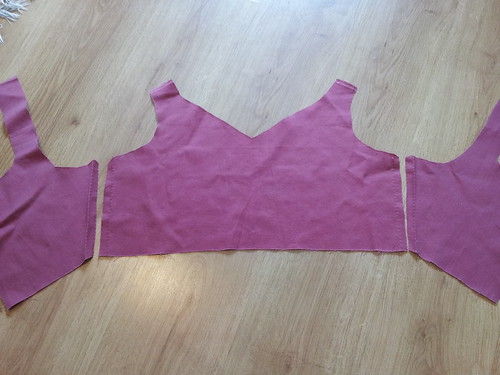
Oh well. 45 minutes of my life down the drain. Still, now that I've got that particular issue resolved, I can move on.
I've done all the pad stitching. It's not really something you can see in the fabric, but it's gone from having a ton of drape to being able to support its own weight. Very cool stuff. (I was a little dubious, but it totally worked.)
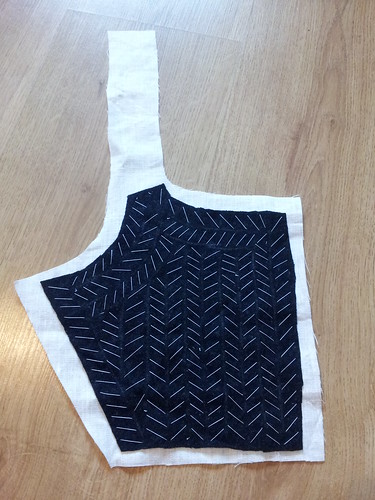
The reason for the ripping is that I'm going to seam the outer and the interlining together at the same time, like so.
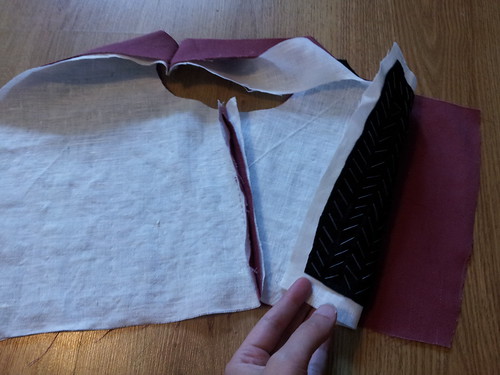
Again, I'm really glad that I decided to make this practice dress first. I'm discovering a whole lot of things that will make v. 2 much better. Take the lining, for example. Making that up first was a bad call. I hadn't considered how much the pad stitching was going to warp the underlining, nor how much bagging there would be between the inner and outer layers.
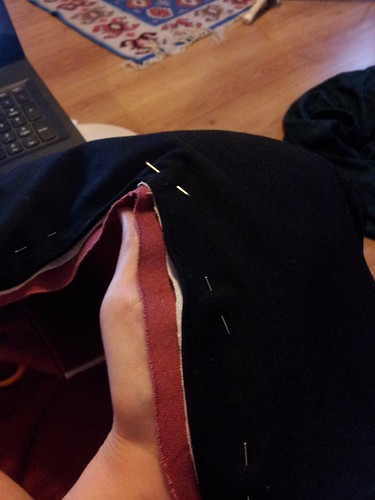
Consequently, the lining isn't going to fit perfectly inside the bodice. It won't be terribly off, but it will bug me. So, next time:
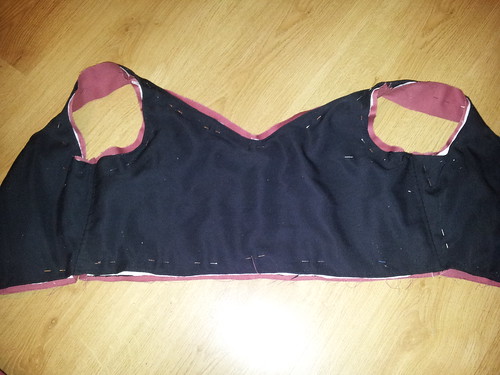
For today's bonus, a little hairstyling experiment. If I'm going to pull this look off properly, I'm going to need the right hair! Still needs a little practice and a cap to go over it, but I'm getting there.


Oh well. 45 minutes of my life down the drain. Still, now that I've got that particular issue resolved, I can move on.
I've done all the pad stitching. It's not really something you can see in the fabric, but it's gone from having a ton of drape to being able to support its own weight. Very cool stuff. (I was a little dubious, but it totally worked.)

The reason for the ripping is that I'm going to seam the outer and the interlining together at the same time, like so.

Again, I'm really glad that I decided to make this practice dress first. I'm discovering a whole lot of things that will make v. 2 much better. Take the lining, for example. Making that up first was a bad call. I hadn't considered how much the pad stitching was going to warp the underlining, nor how much bagging there would be between the inner and outer layers.

Consequently, the lining isn't going to fit perfectly inside the bodice. It won't be terribly off, but it will bug me. So, next time:
- assemble padded interlining pieces
- cut out outer shell fabric
- seam outer and interlining together
- finish edges of outer onto interlining
- cut out and assemble lining to fit inside the completed shell
- insert lining

For today's bonus, a little hairstyling experiment. If I'm going to pull this look off properly, I'm going to need the right hair! Still needs a little practice and a cap to go over it, but I'm getting there.

Saturday, 13 June 2015
A digression into rectangles
Work on the bodice continues apace, but it occurred to me that I'm going to need a skirt in order for this project to become a dress. Everything I've been able to track down seems to indicate that the skirt ought to be a single rectangle of fabric, hemmed at the bottom and gathered at the waist to fit into the bodice. That actually works well with my fabric, as I had only just enough to cut out the bodice pieces and leave three long panels for the skirt.
I can't sew the tube all the way shut until the bodice is done. I'm going to need to be able to pull it on over my head, and I may need to create a placket of sorts at the top of the waist to give me enough room. I wanted to get it hemmed, though, so I've partially sewn and finished that last long seam to allow me to do so.
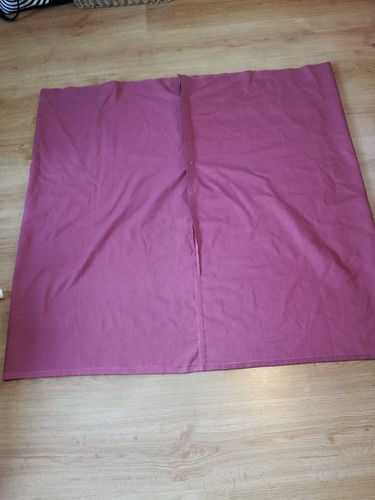
For now, back to the bodice.
I can't sew the tube all the way shut until the bodice is done. I'm going to need to be able to pull it on over my head, and I may need to create a placket of sorts at the top of the waist to give me enough room. I wanted to get it hemmed, though, so I've partially sewn and finished that last long seam to allow me to do so.

For now, back to the bodice.
Friday, 12 June 2015
Bodicing, now with actual fabric content!
Or, the Fiend found her pink sewing thread and there was great rejoicing.
I'm deep into the process of assembling my experimental bodice at this point. Inevitably, it's rather more complicated than I'd expected. Totally vindicated on my decision to make an entire practice dress before playing with the silk.
Take the fabric sandwich, for example. You've got your outer shell of fabric, which is what people will be able to see when you're wearing the dress.
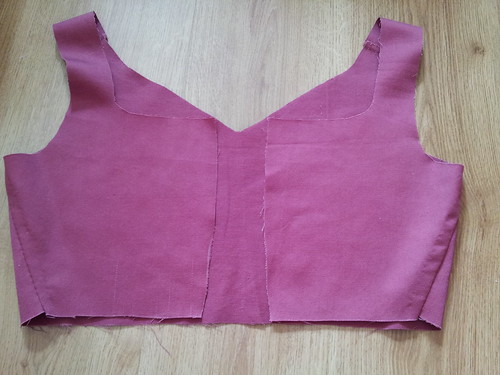
You've got your lining.
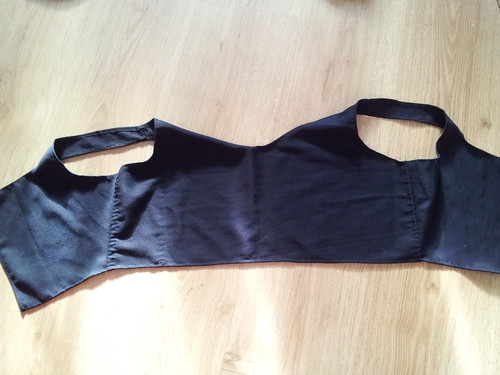
And then there's the padding sandwiched in between the two.
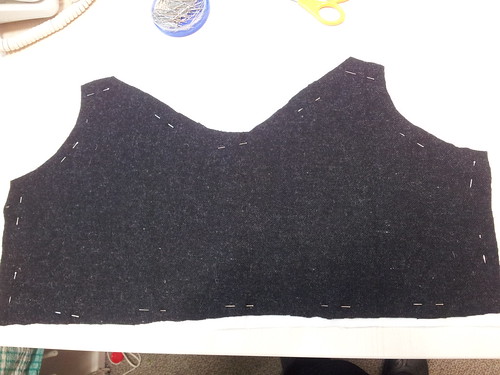
Because I'm doing all of this by hand rather than with a machine, I'm able to use the "period"[1] construction method of assembling the outer shell and lining separately, hemming each of them, and then whipping them together all the way around the edges. It makes for much smoother joins and also means that the lining is removable (and therefore can be washed separately[2]).
My original plan had been to sew the padding directly to the shell of the lining. No dice, though. You see, when you're pad-stitching, the fabric layers pick up a slight curve from being draped over your hand.
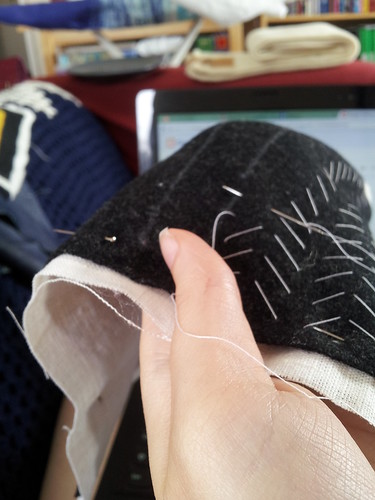
That curve needs to follow the curve of the body. In this beautiful diagram (or not!) you can see the curves of fabric over the bosom.
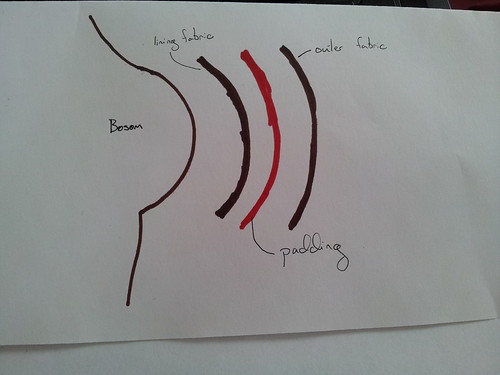
When pad-stitching, you work with the outside edge of the curve uppermost in your hand, as indicated by the arrow:

However, bodies go out AND in. We are not spheres. (Thankfully - just think of all those curved seams to make clothing!) Imagine, then, that the line of fabric continued down the body and dipped in under the bustline before going out again. You'd need to pad-stitch from the opposite side of the fabric.
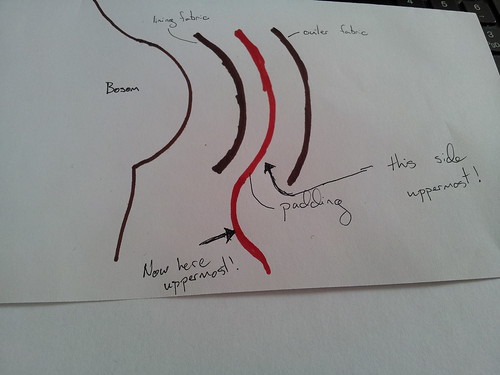
If you were attaching the padding directly to the lining, you'd get unsightly chicken scratching thread lines all over the inside when you swapped to the reverse for the curves, and that wouldn't do at all. Fortunately there's a solution - more fabric!
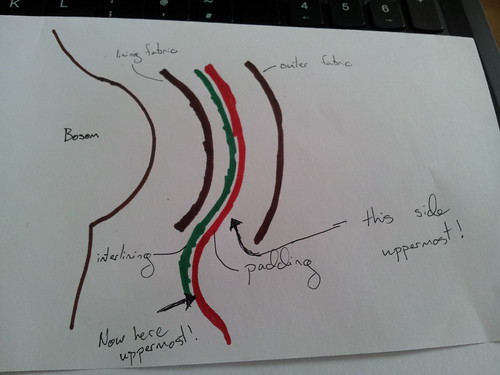
Instead of attaching the padding to the lining, you attach it to an interlining (shown in green above). That way you can sew the curves from both sides and then it all gets hidden between the outer shell and lining fabrics. Delicious, delicious fabric sandwich. Mmmmm, interlining...
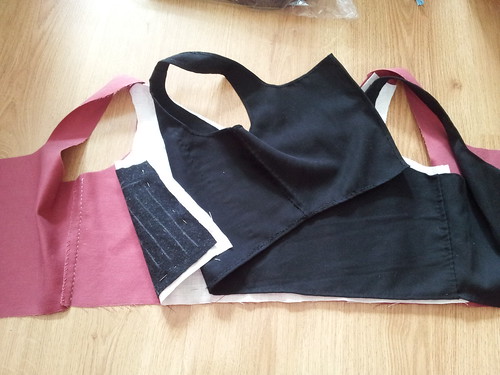
Anyway.
I have the lining assembled and hemmed. The outer shell is assembled, but will get hemmed over the interlining once it's finished. Current goal - pad-stitch ALL THE THINGS!
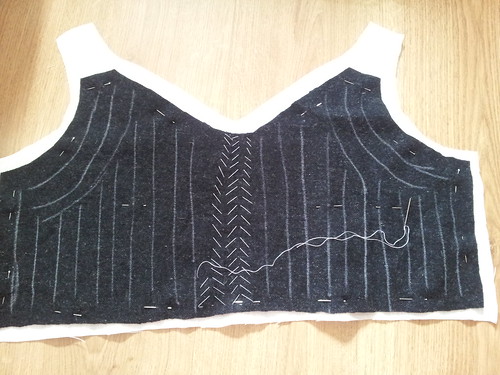
(I attempted to do the pad-stitching freehand. Yeah. That didn't work so well. Sewing straight lines over a curved plane is hard. I've now chalked guidelines, so it should hopefully work better.)
[1] "Period" is SCA shorthand for "stuff that we can document as having happened or existed in Europe before 1600". Also, sorry, Boss Laurel. Bad apprentice, no cookie. (She scolds me for describing things as period.)
[2] You know you've got the historical sewing bug when you choose a construction method based on whether or not you can disassemble the whole thing in order to better wash it.
I'm deep into the process of assembling my experimental bodice at this point. Inevitably, it's rather more complicated than I'd expected. Totally vindicated on my decision to make an entire practice dress before playing with the silk.
Take the fabric sandwich, for example. You've got your outer shell of fabric, which is what people will be able to see when you're wearing the dress.

You've got your lining.

And then there's the padding sandwiched in between the two.

Because I'm doing all of this by hand rather than with a machine, I'm able to use the "period"[1] construction method of assembling the outer shell and lining separately, hemming each of them, and then whipping them together all the way around the edges. It makes for much smoother joins and also means that the lining is removable (and therefore can be washed separately[2]).
My original plan had been to sew the padding directly to the shell of the lining. No dice, though. You see, when you're pad-stitching, the fabric layers pick up a slight curve from being draped over your hand.

That curve needs to follow the curve of the body. In this beautiful diagram (or not!) you can see the curves of fabric over the bosom.

When pad-stitching, you work with the outside edge of the curve uppermost in your hand, as indicated by the arrow:

However, bodies go out AND in. We are not spheres. (Thankfully - just think of all those curved seams to make clothing!) Imagine, then, that the line of fabric continued down the body and dipped in under the bustline before going out again. You'd need to pad-stitch from the opposite side of the fabric.

If you were attaching the padding directly to the lining, you'd get unsightly chicken scratching thread lines all over the inside when you swapped to the reverse for the curves, and that wouldn't do at all. Fortunately there's a solution - more fabric!

Instead of attaching the padding to the lining, you attach it to an interlining (shown in green above). That way you can sew the curves from both sides and then it all gets hidden between the outer shell and lining fabrics. Delicious, delicious fabric sandwich. Mmmmm, interlining...

Anyway.
I have the lining assembled and hemmed. The outer shell is assembled, but will get hemmed over the interlining once it's finished. Current goal - pad-stitch ALL THE THINGS!

(I attempted to do the pad-stitching freehand. Yeah. That didn't work so well. Sewing straight lines over a curved plane is hard. I've now chalked guidelines, so it should hopefully work better.)
[1] "Period" is SCA shorthand for "stuff that we can document as having happened or existed in Europe before 1600". Also, sorry, Boss Laurel. Bad apprentice, no cookie. (She scolds me for describing things as period.)
[2] You know you've got the historical sewing bug when you choose a construction method based on whether or not you can disassemble the whole thing in order to better wash it.
Tuesday, 9 June 2015
Constructing the bodice
The lack of extant clothing from this period of Florentine history means that a lot of conjecture has to go into making versions of it. One of the great mysteries of the high renaissance in Italy is how to create a supportive bodice that doesn't buckled under the weight of one's cleavage while still maintaining the soft, curved silhouette seen in portraits. Foundation garments? Boning? Something else?
While some of the portraits in my inspiration pile have a layer in between the linen camicia and the laced outer
some clearly do not.
While it's entirely possible that some sort of foundation garment was worn under the camicia, I have no idea what it might have looked like or how to construct it, so I'm going to go with just the camicia.
To me (and I'll be the first to admit I'm not an expert) it looks like these dresses aren't boned in the bodice. I have clothing with boned bodices, and there is always a shelf effect at the top. It's a result of the boning not following the curve of the body. All of the portraits I've found with this style of clothing lie flush against the skin.
What I'm going to attempt, therefore, is the same construction method used to make shaped doublets. In between the outer fabric and the lining I'm going to use wool felt and pad-stitch it to create gentle shaping over the bust. My theory is that the layered felt will be stiff enough to keep the bodice in shape while still molding to my body. It should also minimize wrinkles and buckling under my bosom.
Of course, I've never actually made a doublet in this manner. Before I start playing with the red silk, I've decided to make a practice version of the dress. It'll use the same construction method, but cheaper materials - in this case some cotton canvas, leftover wool from that cloak I butchered a while back, and cotton taken from an old skirt. That way I'll be able to make all the inevitable screw-ups and see how the dress wears in time to correct the problems in the "real" dress.
While some of the portraits in my inspiration pile have a layer in between the linen camicia and the laced outer
 |
| Photo from Wikipedia |
some clearly do not.
 |
| From the Metropolitan Museum of Art |
While it's entirely possible that some sort of foundation garment was worn under the camicia, I have no idea what it might have looked like or how to construct it, so I'm going to go with just the camicia.
To me (and I'll be the first to admit I'm not an expert) it looks like these dresses aren't boned in the bodice. I have clothing with boned bodices, and there is always a shelf effect at the top. It's a result of the boning not following the curve of the body. All of the portraits I've found with this style of clothing lie flush against the skin.
What I'm going to attempt, therefore, is the same construction method used to make shaped doublets. In between the outer fabric and the lining I'm going to use wool felt and pad-stitch it to create gentle shaping over the bust. My theory is that the layered felt will be stiff enough to keep the bodice in shape while still molding to my body. It should also minimize wrinkles and buckling under my bosom.
Of course, I've never actually made a doublet in this manner. Before I start playing with the red silk, I've decided to make a practice version of the dress. It'll use the same construction method, but cheaper materials - in this case some cotton canvas, leftover wool from that cloak I butchered a while back, and cotton taken from an old skirt. That way I'll be able to make all the inevitable screw-ups and see how the dress wears in time to correct the problems in the "real" dress.
Friday, 5 June 2015
Bodices and Florentine portraits
I have an ample bosom. The most challenging part of any sort of fitted garment is always going to be the bodice, especially in situations like this where I won't be wearing any modern foundation garments underneath. Of course, I've never actually made any sort of structural bodice, and even if I had there aren't any extant garments from this period to get patterns from.
Ah well, nothing like a challenge, right?
Weaving Friend came to visit and showed me her trick for starting a bodice block: using a pillowcase. It's already a torso-shaped tube, so the "careful" application of scissors, Sharpie, and pins resulted in something resembling a bodice.
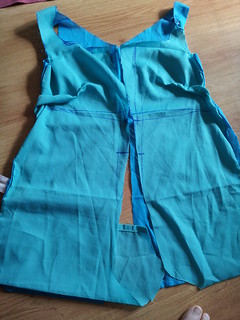
Incidentally, having someone walking around your body with a pair of fabric shears is pretty scary. Fortunately Weaving Friend is pretty awesome and only a little scary.
Once we'd gotten this made, I made a second block from the same polycotton bedding as the pillowcase. It's too flimsy to do any of the structural experimentation, but it's good as a way to measure things like the length of the straps.
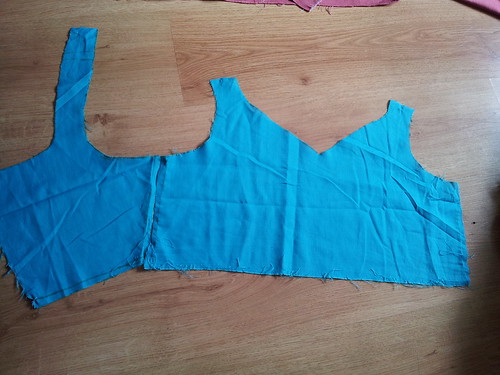
Next up, the block for fitting and lacing. This one is made of a denim offcut I bought years ago. It's not what I'll be using for the garment, but it's heavy, stiff fabric, so I can get a sense of how the lined bodice will behave.
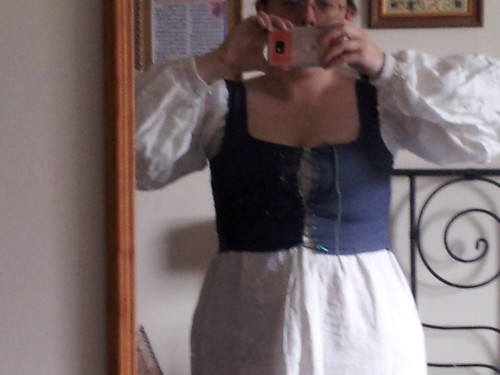
There are some wrinkles under the bust, but not too many. What is very obvious in this picture is that I've cut the front panels too wide. There should be a gap of several inches between the laced fronts, but they meet in the middle all the way up.
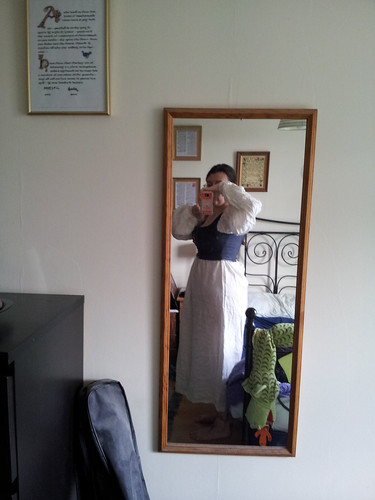
The side silhouette is pretty good, though looking at it I think the armscyes are too far forward. If I trim about a centimetre off the side seam on the front panels, that should fix both the armscye placement and the front opening. The straps are also too long. There ought to be a little more lift than there is.
And finally, the back view.
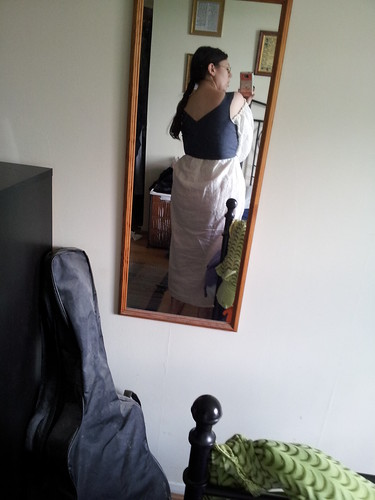
This is where you can see the only real issue with the German chemise. There aren't any gores, which is what's causing the weird bunching over my butt. Other than that, the length is pretty good. And the bunching won't be visible once there's a skirt attached to the bodice.
You can see shoulder seams in this portrait:
They are pretty far in the back, which is what I've done with the block in the above photos.
The composition of the original painting, along with the style and dress, suggests to me that it is most likely from the workshop of Ghirlandaio, giving it an approximate date of of 1480-1494. See how similar they look?


This one even has a hint of a lace cap, too, and what looks like strings tied under the chin.
Helpfully, the original of my painting was last seen in the 1930s, but its current whereabouts are unknown. I'm going to try to track down the article in which it was cited, but that may take a while.
Ah well, nothing like a challenge, right?
Weaving Friend came to visit and showed me her trick for starting a bodice block: using a pillowcase. It's already a torso-shaped tube, so the "careful" application of scissors, Sharpie, and pins resulted in something resembling a bodice.

Incidentally, having someone walking around your body with a pair of fabric shears is pretty scary. Fortunately Weaving Friend is pretty awesome and only a little scary.
Once we'd gotten this made, I made a second block from the same polycotton bedding as the pillowcase. It's too flimsy to do any of the structural experimentation, but it's good as a way to measure things like the length of the straps.

Next up, the block for fitting and lacing. This one is made of a denim offcut I bought years ago. It's not what I'll be using for the garment, but it's heavy, stiff fabric, so I can get a sense of how the lined bodice will behave.

There are some wrinkles under the bust, but not too many. What is very obvious in this picture is that I've cut the front panels too wide. There should be a gap of several inches between the laced fronts, but they meet in the middle all the way up.

The side silhouette is pretty good, though looking at it I think the armscyes are too far forward. If I trim about a centimetre off the side seam on the front panels, that should fix both the armscye placement and the front opening. The straps are also too long. There ought to be a little more lift than there is.
And finally, the back view.

This is where you can see the only real issue with the German chemise. There aren't any gores, which is what's causing the weird bunching over my butt. Other than that, the length is pretty good. And the bunching won't be visible once there's a skirt attached to the bodice.
You can see shoulder seams in this portrait:
 |
| Botticelli, c. 1475 |
The composition of the original painting, along with the style and dress, suggests to me that it is most likely from the workshop of Ghirlandaio, giving it an approximate date of of 1480-1494. See how similar they look?


This one even has a hint of a lace cap, too, and what looks like strings tied under the chin.
Helpfully, the original of my painting was last seen in the 1930s, but its current whereabouts are unknown. I'm going to try to track down the article in which it was cited, but that may take a while.
Thursday, 4 June 2015
And now for something completely different.
A while ago I found a painting on Pinterest. I was looking for something else entirely, but it grabbed my attention and I've not been able to get it out of my head since.
So, as a brief pause in the making of male Tudor clothing (musn't forget to post about the finished jerkin and puffy pants), I'm going to attempt some late 15th-century female Florentine clothing. You know, 'cause I have all that free time.
I've never made anything like this before, so the first attempt is probably going to be All Wrong. We'll see. First step is research. I've spent a chunk of my day collecting paintings of women in similar clothing. The first thing I've noticed is that the approximate date of this painting seems to be about 10-15 years off. Paintings of women in this style all appear to originate in the 1480s and 1490s, so I'm going to work with that.
Components
Of course there's a linen chemise (which I ought not to call a chemise but a camicia), because I need more linen undergarments in my life. The Tudor shirt won't work, since the neckline is radically different, but I do have a German chemise that goes under a Cranach gown that has disappeared somewhere in my mother's house. It has the round neckline and the puffy sleeves, and although it's gathered into a slight ruffle rather than a whitework band, it'll do as a starting point. (Did I mention I'm hoping to pull this outfit together by the beginning of August?)
Some of the portraits have some sort of contrasting panel over the camicia underneath the bust lacing. Some clearly don't, based on the way the layer of white fabric is bunched up. Since I'm going to be wearing this in August, I'd rather have as few layers as possible.
Over the camicia I'll be wearing a gown with a front-lacing bodice, then. I'm not entirely sure what's going on with the bars at the top of the laced opening. They look like brass rods, and then lacing cord underneath with some sort of brooch/ornament/flower tucked under.
The sash and sleeves look to me to be made of black velvet. The sleeves are in two pieces, laced together at the elbow and forearm. It's not clear how they're attached to the dress. They do seem to be attached only at a single point, though, which to me implies that they are either pinned on or laced on. If they were sewn there would be more of a flat seam than the single point of connection that's visible here.
There's a sheer silk partlet over the top of the bodice.
She's wearing a round pendant that appears to be metal, strung onto some sort of black cord that's looped twice around her throat. She also has on a single ring that appears to be set with a stone or stones.
She's got a really unusual cap on. Although the hairstyle is what seems to be the usual Florentine 'do for this period, the caps are usually plain linen. This appears to be either lace or sheer embroidered silk.
And although they're not visible, I will need some sort of shoes and stockings. More research there, since I've no idea what would be appropriate.
Eventually I'll need one of the loose overgowns, too. Not by August, though. I'm ambitious, not insane.
 |
| Photo taken from this website. |
So, as a brief pause in the making of male Tudor clothing (musn't forget to post about the finished jerkin and puffy pants), I'm going to attempt some late 15th-century female Florentine clothing. You know, 'cause I have all that free time.
I've never made anything like this before, so the first attempt is probably going to be All Wrong. We'll see. First step is research. I've spent a chunk of my day collecting paintings of women in similar clothing. The first thing I've noticed is that the approximate date of this painting seems to be about 10-15 years off. Paintings of women in this style all appear to originate in the 1480s and 1490s, so I'm going to work with that.
Components
Of course there's a linen chemise (which I ought not to call a chemise but a camicia), because I need more linen undergarments in my life. The Tudor shirt won't work, since the neckline is radically different, but I do have a German chemise that goes under a Cranach gown that has disappeared somewhere in my mother's house. It has the round neckline and the puffy sleeves, and although it's gathered into a slight ruffle rather than a whitework band, it'll do as a starting point. (Did I mention I'm hoping to pull this outfit together by the beginning of August?)
 |
| Hmm. Possibly I need more sun... |
Some of the portraits have some sort of contrasting panel over the camicia underneath the bust lacing. Some clearly don't, based on the way the layer of white fabric is bunched up. Since I'm going to be wearing this in August, I'd rather have as few layers as possible.
Over the camicia I'll be wearing a gown with a front-lacing bodice, then. I'm not entirely sure what's going on with the bars at the top of the laced opening. They look like brass rods, and then lacing cord underneath with some sort of brooch/ornament/flower tucked under.
The sash and sleeves look to me to be made of black velvet. The sleeves are in two pieces, laced together at the elbow and forearm. It's not clear how they're attached to the dress. They do seem to be attached only at a single point, though, which to me implies that they are either pinned on or laced on. If they were sewn there would be more of a flat seam than the single point of connection that's visible here.
There's a sheer silk partlet over the top of the bodice.
She's wearing a round pendant that appears to be metal, strung onto some sort of black cord that's looped twice around her throat. She also has on a single ring that appears to be set with a stone or stones.
She's got a really unusual cap on. Although the hairstyle is what seems to be the usual Florentine 'do for this period, the caps are usually plain linen. This appears to be either lace or sheer embroidered silk.
And although they're not visible, I will need some sort of shoes and stockings. More research there, since I've no idea what would be appropriate.
Eventually I'll need one of the loose overgowns, too. Not by August, though. I'm ambitious, not insane.
Sossidges*
The event of cookery went well - the food was served at the right temperatures and on time, everyone seemed happy with it, and we hit the sweet spot of just enough leftovers that people had clearly eaten their fill but not so much there was a ton of wasted food. And the best part was that we in the kitchen actually had fun and got to participate in some of the other activities.
Rather than write up the whole feast as a single massive post, I'm going to do it one dish at a time. First up, fried sausages!
This is a slightly tweaked version of Peter Brears' sausage recipe (2015, p. 356), which is itself an amalgamation of three 17th-century recipes. I've increased the amount of black pepper, because I find that fatty sausages cooked in their own fat need the extra bite not to tasty greasy and gross.
Brears recommends rolling the sausage meat out into logs if one isn't using casings, but in order to fit more into the frying pans I rolled them into balls instead.
Fry the sausages over a medium heat until they are cooked through and nicely browned. I didn't add any extra fat to the frying pan, as without casings some of the fat from the meat inevitably renders out.
Yield: about 100 walnut-sized sausage balls.
These may well be the tastiest sausages I've ever eaten, and as my mother used to make her own, I've tried a lot of different kinds.
*A Pratchett-ism that has slipped into the family lexicon.
**You could of course just mince the meat by hand, but if there's a meat grinder to hand I'd use that. It's faster. Alternatively, go find a nice butcher, give them your spice blend, and ask them to grind up the meat in the right ratio with the spices.
Rather than write up the whole feast as a single massive post, I'm going to do it one dish at a time. First up, fried sausages!
This is a slightly tweaked version of Peter Brears' sausage recipe (2015, p. 356), which is itself an amalgamation of three 17th-century recipes. I've increased the amount of black pepper, because I find that fatty sausages cooked in their own fat need the extra bite not to tasty greasy and gross.
- 1 kg lean pork
- 0.5 kg pork fat
- 1 tsp ground mace
- 1 tsp ground cloves
- 1 rounded tsp ground black pepper
- 2 tsp salt
- 4 tsp dried sage
Brears recommends rolling the sausage meat out into logs if one isn't using casings, but in order to fit more into the frying pans I rolled them into balls instead.
Fry the sausages over a medium heat until they are cooked through and nicely browned. I didn't add any extra fat to the frying pan, as without casings some of the fat from the meat inevitably renders out.
Yield: about 100 walnut-sized sausage balls.
These may well be the tastiest sausages I've ever eaten, and as my mother used to make her own, I've tried a lot of different kinds.
*A Pratchett-ism that has slipped into the family lexicon.
**You could of course just mince the meat by hand, but if there's a meat grinder to hand I'd use that. It's faster. Alternatively, go find a nice butcher, give them your spice blend, and ask them to grind up the meat in the right ratio with the spices.
Sunday, 24 May 2015
Experimental biscuitry
I am at the tail end of preparing for the event of cookery and I've just one recipe left to test. It's for the nibbly dessert biscuits, and is the only recipe I'm redacting from the original myself.
Take a quart of life Hony, and set it upon the fire and when it seetheth scum it clean, and then put in a certaine of fine Biskets well serced, and some pouder of Cloves, some Ginger, and powder of sinamon, Annis seeds and some Sugar, and let all these be well stirred upon the fire, til it be as thicke as you thinke needfull, and for the paste for them take Flower as finelye dressed as may be, and a good peece of sweet Butter, and woorke all these same well togither, and not knead it.
(Originally published in 1584.)
I'm interpreting that as:
There is no leavening agent in this recipe, so the resulting biscuits are going to be very dense. It's almost going to be a spiced candy paste wrapped in pastry. Hopefully it'll taste good!
The ingredients are almost identical to those for lebkuchen, and I have a good recipe for those to indicate proportions.
For the trial batch:

They need 10 minutes at 400F/Gas7 to cook the pastry. The filling reliquified on cooking, but I think I overcooked the filling. It really ought to have stayed soft. The ones I tasted fresh from the oven are delicious, though! The trick is going to be making sure I stick with soft ball temperatures.

Take a quart of life Hony, and set it upon the fire and when it seetheth scum it clean, and then put in a certaine of fine Biskets well serced, and some pouder of Cloves, some Ginger, and powder of sinamon, Annis seeds and some Sugar, and let all these be well stirred upon the fire, til it be as thicke as you thinke needfull, and for the paste for them take Flower as finelye dressed as may be, and a good peece of sweet Butter, and woorke all these same well togither, and not knead it.
(Originally published in 1584.)
I'm interpreting that as:
- Boil and skim a quart of honey
- Add biscuit crumbs
- Add ground cloves, ginger, ground cinnamon, aniseed, and sugar
- Cook until thickened
- Make pastry out of flour and butter
There is no leavening agent in this recipe, so the resulting biscuits are going to be very dense. It's almost going to be a spiced candy paste wrapped in pastry. Hopefully it'll taste good!
The ingredients are almost identical to those for lebkuchen, and I have a good recipe for those to indicate proportions.
For the trial batch:
- 1/2 cup of honey
- 1/3 cup of sugar
- 1/2 tsp each of the spices
- 1/3 cup of crushed Digestive biscuits.
- Regular pastry, including water to hold it together.

They need 10 minutes at 400F/Gas7 to cook the pastry. The filling reliquified on cooking, but I think I overcooked the filling. It really ought to have stayed soft. The ones I tasted fresh from the oven are delicious, though! The trick is going to be making sure I stick with soft ball temperatures.

Friday, 17 April 2015
Further sock mathery
Actual gauge with this needle/yarn combo is 4 stitches per inch, not 5. If this were a regular pair of socks I'd rip it out and cast on again, but since these are thigh-highs I can just pull them farther up the leg until they fit properly.
By the time I get to the bottom of the calf muscle I need to be down to 28 stitches. The length from thigh to calf is 16 inches. Decreasing 52 stitches over 16 inches means I need to decrease three stitches every inch plus 4 stitches somewhere.
Vertical gauge is 6 rounds per inch. So basically I need to decrease one stitch every other round. However, I've already knit an inch of the sock plain. (I'm not doing ribbing at the top because I'll be wearing garters and the top of the socks will be fastened under my trousers anyway.) I also want to do the four extra decreases towards the top of the leg because that's where the sharpest decreases in the shape of my leg happen. Something resembling Real Knitting Instructions:
Further instructions will follow once I decide what sort of heel I'm doing.

By the time I get to the bottom of the calf muscle I need to be down to 28 stitches. The length from thigh to calf is 16 inches. Decreasing 52 stitches over 16 inches means I need to decrease three stitches every inch plus 4 stitches somewhere.
Vertical gauge is 6 rounds per inch. So basically I need to decrease one stitch every other round. However, I've already knit an inch of the sock plain. (I'm not doing ribbing at the top because I'll be wearing garters and the top of the socks will be fastened under my trousers anyway.) I also want to do the four extra decreases towards the top of the leg because that's where the sharpest decreases in the shape of my leg happen. Something resembling Real Knitting Instructions:
- Cast on 80 stitches. Distribute onto four needles and join for knitting in the round, being careful not to twist.
- Knit six rounds plain.
- Decrease one stitch every round for 14 rounds in a column at the back of the leg. 66 stitches remain. Redistribute stitches evenly across needles.
- Starting with a plain row, decrease one stitch every other round in the same column until 28 stitches remain. Redistribute stitches evenly as necessary.
- Knit plain until you reach the ankle bone.
Further instructions will follow once I decide what sort of heel I'm doing.

Thursday, 16 April 2015
Next up: nether hose
Now that the shirt is out of the way, I need to get on with the next piece of my Tudor shooting outfit. This will be a pair of knitted nether hose, which are basically over-the-knee-socks. You see fancy silk ones from the middle of the 16th century, but there's evidence of woolly ones being worn earlier.
I have a stash of ancient handspun yarn from Bulgaria. (I have this vague memory that my parents bought it for my grandmother shortly after we moved there more than 20 years ago.)

It's a bit heavier than I'd usually do socks - aran rather than fingering - but it's lovely crunchy wool and should knit up beautifully. Also way faster than doing fingering-weight thigh-highs. Additionally, these are hose for wearing outdoors doing archery. I want them to keep my legs warm!
I'd do a gauge swatch, but I conveniently have a pair of bedsocks I knit up for the Spouse a few years ago in a similar weight.

Gauge is 5 stitches per inch on 4mm needles. The bit of my thigh I want the top to encompass is 18 inches, but it needs to fit snugly in order to stay up. Fortunately, there's a splendid worksheet online to help with calculating how big around the stocking needs to be. I'm going top-down rather than toe-up because of personal preference. It's a generic sock, not something fancy.
Plugging my gauge into the worksheet comes out at 81 stitches; I'm working with 5 needles, so I'll cast on 80 to make the numbers easier to deal with. Then it'll just be stockinette with decreases all the way down.
I have a stash of ancient handspun yarn from Bulgaria. (I have this vague memory that my parents bought it for my grandmother shortly after we moved there more than 20 years ago.)

It's a bit heavier than I'd usually do socks - aran rather than fingering - but it's lovely crunchy wool and should knit up beautifully. Also way faster than doing fingering-weight thigh-highs. Additionally, these are hose for wearing outdoors doing archery. I want them to keep my legs warm!
I'd do a gauge swatch, but I conveniently have a pair of bedsocks I knit up for the Spouse a few years ago in a similar weight.

Gauge is 5 stitches per inch on 4mm needles. The bit of my thigh I want the top to encompass is 18 inches, but it needs to fit snugly in order to stay up. Fortunately, there's a splendid worksheet online to help with calculating how big around the stocking needs to be. I'm going top-down rather than toe-up because of personal preference. It's a generic sock, not something fancy.
Plugging my gauge into the worksheet comes out at 81 stitches; I'm working with 5 needles, so I'll cast on 80 to make the numbers easier to deal with. Then it'll just be stockinette with decreases all the way down.
Subscribe to:
Comments (Atom)





